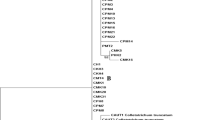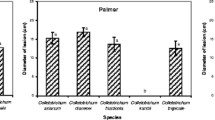Abstract
Anthracnose, caused by Colletotrichum spp., has caused damage and great losses in peach orchards in two Brazilian states, Santa Catarina (SC) and São Paulo (SP). There is limited information on the characterization of Colletotrichum spp. from those locations. In this study we characterized Colletotrichum spp. isolated from peach fruit from SC and SP, and compared them to a reference isolate of Colletotrichum gloeosporioides, using molecular and traditional tools. Molecular analysis revealed that all isolates (7) belong to C. acutatum species complex (Cac) and three of them are C. nymphaeae. Most of the isolates showed distinct characteristics among them for most of the variables assessed using traditional methods. The optimum temperature for mycelial growth ranged from 24 to 26 °C, for conidial germination it ranged from 22.7 to 24.6 °C, and for germ tube length the temperature ranged from 21.3 to 27.3 °C. Disease severity caused by the Cac isolates was similar when compared wounded and nonwounded fruits. The PrpCnSP13–19 isolate was the most aggressive. More severe anthracnose symptoms were observed in fruits inoculated and maintained at simulated temperatures of São Paulo state when compared to fruits inoculated and maintained at simulated temperatures of the states of Paraná, Santa Catarina and Rio Grande do Sul. Our results suggest that there are different strains of Cac, with different level of aggressiveness and optimum temperatures for disease development.


Similar content being viewed by others
References
Adaskaveg E, Hartin RJ (1997) Characterization of Colletotrichum acutatum isolates causing anthracnose of almond and peach in California. Phytopathol 87:979–987
Bailey JA, O'Connell RJ, Pring RJ, Nash C (1992) Infection strategies of Colletotrichum species. Colletotrichum: Biol Pathol Control:88–120
Bassanezi RB, Amorim L, Bergamin Filho A, Hau B (1998) Effects of bean line pattern mosaic virus on the monocyclic components of rust and angular leaf spot of Phaseolus bean at different temperatures. Plant Pathol 47:289–298
Bernstein B, Zehr EI, Dean RA, Shabi E (1995) Characteristics of Colletotrichum from peach, apple, pecan, and other hosts. Plant Dis 79:478–482
Bragança CAD, Damm U, Baroncelli R, Massola Júnior NS, Crous PW (2016) Species of the Colletotrichum acutatum complex associated with anthracnose diseases of fruit in Brazil. Fungal Biol 120:547–561
Bueno CRNC (2005) Identificação e caracterização das espécies de Colletotrichum causadoras de antracnose em hortaliças solanáceas (Master), Universidade de São Paulo, Piracicaba, SP
Cai L, Hyde KD, Taylor PWJ, Weir BS, Waller J, Abang MM, Zhang JZ, Yang YL, Phoulivong S, Liu ZY, Prihastuti H, Shivas RG, Mckenzie EHC, Johnston PR (2009) A polyphasic approach for studying Colletotrichum. Fungal Diver 39:183–204
Carbone I, Kohn LM (1999) A method for designing primer sets for speciation studies in filamentous ascomycetes. Mycol 91:553–556
Chen SN, Luo CX (2016) Sensitivity of Colletotrichum species, including C fioriniae and C nymphaeae from peach to demethylation inhibitor fungicides. Plant Dis 100:2434–2441
Damm U, Cannon PF, Woudenberg JHC, Crous PW (2012) The Colletotrichum acutatum species complex. Stud Mycol 73:37–113
Dias MD, Pozza EA, de Abreu MS, Miranda EO (2005) Effect of temperature on micelial growth, production and conidial germination of Colletotrichum spp from Coffea arabica L. Ciencia e Agrotecnologia 29:545–552
Freeman S, Katan T, Shabi E (1998) Characterization of Colletotrichum species responsible for anthracnose diseases of various fruits. Plant Dis 82:596–605
Gardes M, Bruns TD (1993) ITS primers with enhanced specificity for basidiomycetes - application to the identification of mycorrhizae and rusts. Molec Ecol 2:113–118
Glass NL, Donaldson G (1995) Development of primer sets designed for use with PCR to amplify conserved genes from filamentous ascomycetes. J Appli Environ Microbiol 61:1323–1330
Grabke A, Williamson M, Henderson GW, Schnabel G (2014) First report of anthracnose on peach fruit caused by Colletotrichum truncatum in South Carolina. Plant Dis 98:1154–1154
Guerber JC, Liu B, Correll JC, Johnston PR (2003) Characterization of diversity in Colletotrichum acutatum sensu lato by sequence analysis of two gene introns, mtDNA and intron RFLPs, and mating compatibility. Mycol 95:872–895
Gunnel PS, Gubler W (1992) Taxonomy and morphology of Colletotrichum species pathogenic to strawberry. Mycol 84:157–165
Hu MJ, Grabke A, Schnabel G (2015) Investigation of Colletotrichum gloeosporioides species complex causing peach anthracnose in South Carolina. Plant Dis 99:797–805
Hyde KD, Cai L, Cannon PF, Crouch JA, Crous PW, Damm U, Zhang JZ (2009) Colletotrichum - names in current use. Fungal Diver 39:147–182
Katoh K, Toh H (2008) Recent developments in the MAFFT multiple sequence alignment program brief. Bioinformatics 9:286–298
Martins MC, Betti JA, Leite RMVBC, Amorim L (2005) Doenças das rosáceas de caroço. In: Kimati H, Amorim L, Rezende JAM, Bergamin Filho A, Camargo LEA (eds) Manual de Fitopatologia: doenças das plantas cultivadas. Agronômica Ceres, São Paulo, SP, pp 545–557
May De Mio LL, Garrido L, Ueno B (2004) Doenças de fruteiras de caroço. In: Monteiro LB, May-De-Mio LL, Serrat BM, Motta ACV, Cuquel FL (eds) Fruteiras de caroço: uma visão ecológica. UFPR, Curitiba, PR, pp 169–221
May De Mio LL, Martins MC, Ueno B, Fajardo TVM, Amorim L (2016) Doenças das rosáceas de caroço. In: Amorim L, Rezende JAM, Bergamin Filho A, Camargo LEA (eds) Manual de Fitopatologia: doenças das plantas cultivadas. Agronômica Ceres, São Paulo, SP, pp 629–646
McDermott JM, McDonald BA (1993) Gene flow in plant pathosystems. Annu Rev Phytopathol 31:353–373
McKay SF, Freeman S, Minz D, Maymon M, Sedgley M, Collins GC, Scott ES (2009) Morphological, genetic, and pathogenic characterization of Colletotrichum acutatum, the cause of anthracnose of almond in Australia. Phytopathol 99:985–995
Moreira RR, Peres NA, May De Mio LL (2019) Colletotrichum acutatum and C gloeosporioides species complex associated with apple in Brazil. Plant Dis 103:268–275
Ogawa JM, Zehr EI, Bird GW, Ritchie DD, Uriu K, Uyemoto JK (1995) Compendium of Sone Fruit Diseases. The American Phytopathological Society, St Paul, MN
Oliveira JA (1991) Efeito do tratamento fungicida em sementes no controle de tombamento de plântulas de pepino (Cucumis sativas L ) e pimentão (Capsicum annanum L ) 1991 111p Dissertation (Master in Phytopathology) – Escola Superior de Agricultura de Lavras, Lavras
Pansera MR, Conte RI, Silva SM e, Sartori VC, da Silva Ribeiro RT, (2015) Strategic control of postharvest decay in peach caused by and . Revista Brasileira de Tecnologia Aplicada nas Ciências Agrárias 8
Phoulivong S, McKenzie EHC, Hyde KD (2012) Cross infection of Colletotrichum species; a case study with tropical fruits. Curr Res Enviro Appl Mycol 2:99–111
R Core Team (2013) R: A language environment for statistical computing Vienna: R Foundation for Statistical Computing http://www.R-project.org/
Sanders GM, Korsten L, Wehner FC (2000) Survey of fungicide sensitivity in Colletotrichum gloeosporioides from different avocado and mango production areas in South Africa. Euro J Plant Pathol 106:745–752
Simmonds JH (1965) A study of the species of Colletotrichum causing ripe fruit rots in Queensland. Queens J Agricul Ani Sci 22:437–459
Smith BJ, Black LL (1990) Morphological, cultural, and pathogenic variation among Colletotrichum species isolated from strawberry. Plant Dis 74:69–76
Soares AR, Lourenco SA, Amorim L (2008) Infection of guava by Colletotrichum gloeosporioides and Colletotrichum acutatum under different temperatures and wetting periods. Tropic Plant Pathol 33:265–272
Sutton BC (1992) The genus Glomerella and its Anamorph Colletotrichum. In: Bailey JA, Jeger MJ (eds) Colletotrichum: Biology, Pathology and Control. CAB International, Wallingford, UK, pp 1–26
Tamura K, Peterson D, Stecher G, Filipski A, Kumar S (2013) MEGA6: molecular evolutionary genetics analysis. Molec Biol Evol 30:2725–2729
Tozze Júnior HJ (2012) Antracnose do abacateiro: danos pós-colheita, caracterização do agente causal, quantificação de parâmetros da pré-penetração e monocíclicos e controle químico (Doctorate in Plant Pathology), Universidade de São Paulo, Piracicaba
Tozze Júnior HJ, Firmino AC, Fischer IH, Furtado EL, Massola Júnior ES (2015) Characterization of Colletotrichum spp isolates associated with fruit trees in the state of São Paulo. Summ Phytopathol 41:270–280
Velho AC, Alaniz S, Casanova L, Mondino P, Stadnik MJ (2015) New insights into the characterization of Colletotrichum species associated with apple diseases in southern Brazil and Uruguay. Fungal Biol 119:229–244
Weir BS, Johnston PR, Damm U (2012) The Colletotrichum gloeosporioides species complex. Stud Mycol 73:115–180
Wharton PS, Dieguez-Uribeondo J (2004) The biology of Colletotrichum acutatum. Anales del Jardın Botanico de Madrid 61:3–22
White TJ, Bruns T, Lee S, Taylor RJ (1990) Amplification and direct sequencing of fungal ribosomal RNA genes for phylogenetics. In: Innis MA, Gelfand DH, Shinsky JJ, White TJ (eds) PCR Protocols: a guide to methods and applications, pp 315–322
Wong FP, Midland SL (2007) Sensitivity distributions of California populations of Colletotrichum cereale to the DMI fungicides propiconazole, myclobutanil, tebuconazole, and triadimefon. Plant Dis 91:1547–1555
Woudenberg JHC, Aveskamp MM, Gruyter J, Spiers AG, Crous PW (2009) Multiple Didymella teleomorphs are linked to the Phoma clematidina morphotype. Persoonia 22:56–62
Acknowledgments
We thank to Dr. Nelson S. Massola Júnior from ESALQ-USP for providing the Colletotrichum gloeosporioides isolate. This study was financed in part by the Coordenação de Aperfeiçoamento de Pessoal de Nível Superior - Brasil (CAPES) - Finance Code 001 an by the Conselho Nacional de Desenvolvimento Científico e Tecnológico - Brazil (CNPq).
Author information
Authors and Affiliations
Corresponding author
Rights and permissions
About this article
Cite this article
Moreira, R.R., Araldi Silva, G. & May De Mio, L.L. Colletotrichum acutatum complex causing anthracnose on peach in Brazil. Australasian Plant Pathol. 49, 179–189 (2020). https://doi.org/10.1007/s13313-020-00690-z
Received:
Accepted:
Published:
Issue Date:
DOI: https://doi.org/10.1007/s13313-020-00690-z







